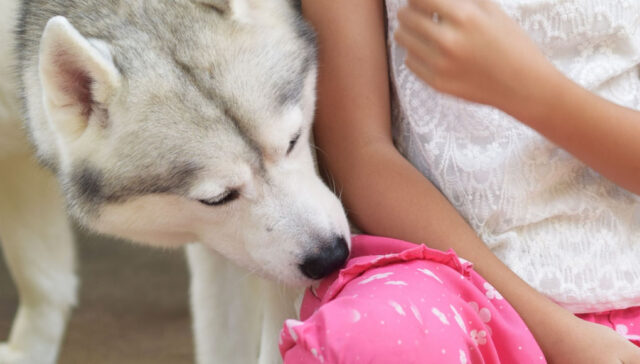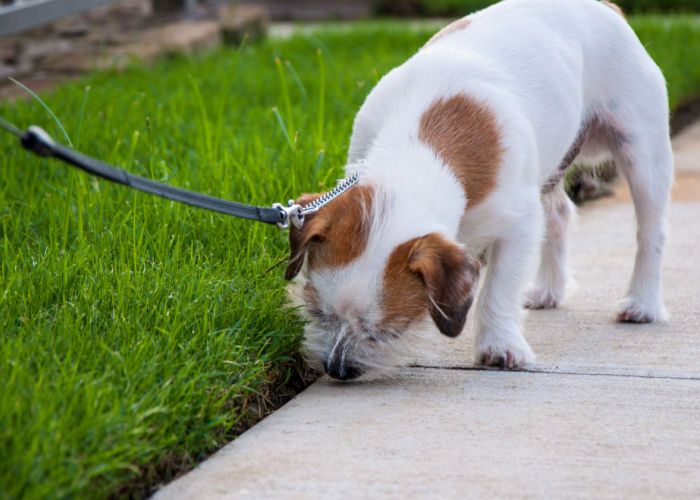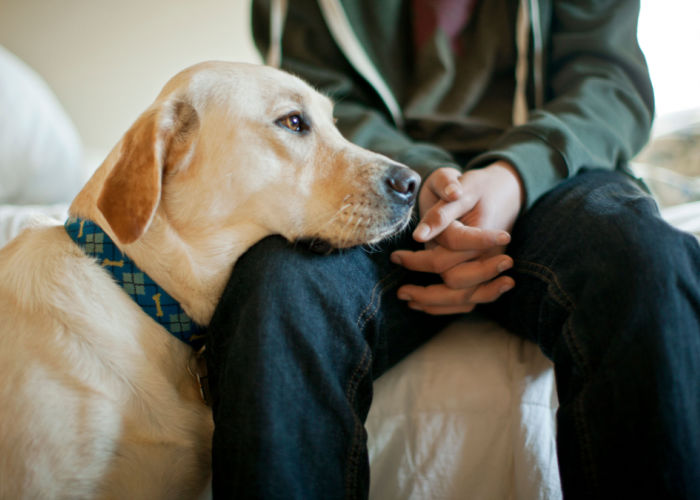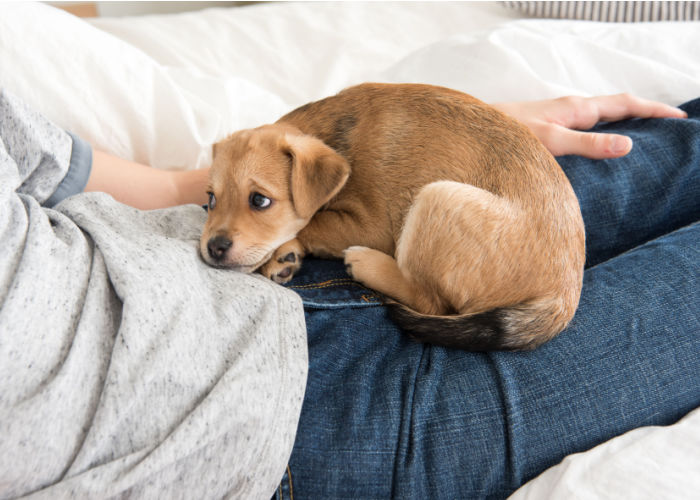
Table of Contents
Picture this: you're having an exciting date night at your place.
It's all going well when your dog enthusiast lover bends down to stroke your pet's fur.
You're staring at them adoringly, relishing the beauty of the moment when your dog decides to sniff your partner's crotch.
The night has escalated dramatically, and an awkward tension is lingering.
Perhaps the only one that still looks satisfied is your four-legged friend who doesn't understand social etiquette and norms.
In this blog, we'll address why dogs smell the crotch area, the importance of a dog's olfactory sense as a communication medium, what messages it can convey, etc.
We'll also explore training techniques to redirect your dog's attention from the crotch area to something more socially appropriate.
So, without further ado, let's get started!
The Sense of Smell in Dogs
Did you know that countless studies have been conducted on the sense of smell among humans vs other animals?
Some researchers have said that “the human sense of smell is impoverished and other animals such as dogs are much better at it than we are.”
While others have also refuted this statement, the facts remain the same: humans have only 400 functioning genes in the genome.
This is in high contrast in dogs with over 850 functional receptor genes.
No wonder dogs mainly navigate their surroundings through their keen sense of smell.
They sniff it whenever they see something that intrigues them or feels a scent they want to know more about.
It’s almost an instinctual internal response to their external environment.

Importance of Dog’s Sense of Smell
A dog’s sense of smell is remarkable, surpassing human abilities significantly.
While a human experiences the world through their five senses, a dog predominantly does it through their adorable nose.
They possess a highly sensitive nasal system that allows them to detect sensations, feelings, and health concerns precisely.
For example, you may not be able to guess that someone has diabetes just by sniffing them.
Or, you may not understand that your friend is upset because of the odor related to changes in the body’s hormones.
Surprisingly, our canine companions can discriminate and assimilate various scents.
No wonder they have been utilized for numerous scent-related jobs in the past. These include:
- Search and rescue dogs to track human scent, locate buried people, and help recuse hidden individuals, for example, underneath rubble caused by an earthquake.
- Police and military dogs that are used for detecting drugs (such as narcotics) and explosives, etc., to capture criminal activity and ensure public safety
- Medical detection dogs can identify health concerns such as cancer, diabetes, and infections, helping doctors diagnose and treat, etc.
The point is that dogs’ incredible sense of smell is not unprecedented in human history. It has been put to numerous good uses for years.
The only problem is when these dogs create uncomfortable situations by going after distinct smells that humans may not be very comfortable with them exploring.
For example, no one wants to have their crotch area sniffed by a dog.
This may be further emphasized by people who are particularly scared of our canine companions and may fear they may bite them.
It’s important to understand that for dogs, it’s a way to understand a human.
For humans, it may be a matter of discomfort and uneasiness—and no one can blame them.
Before we delve into the solutions to a problem, let’s learn about crotch sniffing as a form of communication for our furry friends.
The more we can learn about their innate instincts, the better we’ll be able to channel them into socially appropriate behaviors.
Remember: the trick isn’t to work against nature but with it.
This will help keep your dog learning what is and isn’t acceptable without resorting to aggression.
We’ll later learn to operantly condition it through rewards without resorting to punishment to bring change. This is what will be best in our favor.
Canine Communication
Understanding the reason for specific animal behavior includes in-depth insight into how it communicates. This includes verbal as well as non-verbal communication.
For example, humans interact by saying ‘hello' or greeting each other through a warm handshake or hug.
This is not the case with dogs, who explore the world around them through their sense of smell.
Ever brought a new cuisine or even new clothes home, and your dog wanted to get into the shopping bag and sniff the inside goodies?
This is typical dog behavior and nothing to be afraid of.
The problem only occurs when our communication style is vastly different from our canine companions, and the difference in social cues starts getting embarrassing.
For example, if a visitor came to your home, you wouldn't want your dog to go near them and smell their bums, right?
This would be inappropriate and make it awkward for your guest, who may not be familiar with dogs, and how sniffing for them is a medium of getting to know someone.
This blog section addresses questions regarding dogs' communication styles.
This will allow us to train them to channel their instincts into socially appropriate ways later.
Dog's Communication Methods
Much like humans, dogs communicate through multiple methods.
These include barking, tail wagging, posture, facial expressions, scent marking, and—you guessed it right—sniffing.
While they may not speak English, they use their own dog language to convey their message.
For example, excessive vocalization may indicate anxiety, boredom, stress, or even a need for physical and mental stimulation.
Tail wagging could assert excitement or caution, depending on its movement speed.
In addition, they may urinate or defecate in certain places to convey their territory or reproductive status to other dogs.
In the same way, dogs, which are heavily scent-driven creatures, sniff each other’s crotch area to gather information related to the dog’s identity, health, and emotional state.

The Role of Scent in Dog Communication
What may surprise new owners is that dogs can learn a lot about humans just by sniffing them. These include the following:
Identity
Everyone carries a distinct and unique scent, and dogs can differentiate between people based on their smell.
Emotional State
Dogs can detect what a person feels based on the chemical changes in a person’s body odor.
These include emotions such as fear, stress, happiness, sadness, etc.
Health Conditions
Our talented canine companions can detect underlying conditions such as certain types of cancer, diabetes, seizures, etc.
General Hygiene
They can also detect the presence of bacteria and drugs on a person’s skin or clothes.
Activities
Dogs may be able to pick up scents that give cues to an individual’s recent activities, such as whether they’ve visited a specific location or smells of smoking, cooking, etc.
Other Animals
remember when we talked about dogs’ scent markings as a form of protectiveness over their owners?
Dogs may sense that smell, which may give them information regarding a person’s comfort with animals, etc.
Now, none of these are inherently bad.
All our furry friends want to learn more about you as a form of communication and acknowledgment.
It just happens that the part that they choose as most accessible and scent-oriented is the crotch area.
The truth is that you cannot do much about your dog’s sniffing tendencies as they are deeply innate.
You can train them to channel their curiosity to other parts of the body, such as the hand or palm, etc.

Why Do Dogs Sniff the Crotch Area?
We know that dogs sniff individuals to gather information about them.
It helps them differentiate themselves from people they already know and understand things such as their moods, health, overall well-being, etc.
But what exactly drives our adorable furry friends to the crotch area?
Did you know that our body releases chemical substances like pheromones that relay specific information to our pets?
These are said to be most present in areas such as the groin, armpit area, breasts in females, etc.
The apocrine sweat glands in the axillary and pubic region have the most concentrated levels of these substances, whose scents dogs find so intriguing.
Since an individual’s armpit may be harder to reach than their crotch area, that’s what dogs settle for then.
Other factors that draw dogs to the genital area include temperature, sweat production, and personal hygiene habits.
The sweaty the individual’s body part is, the more pheromone it’s likely to carry, inviting dogs to sniff it and learn more about the individual—be it their owner who understands their behavior or even just a stranger who gets terrified as a scary-looking dog comes near their crotch area.
Differences in Scent Composition Among People
Every individual has a unique biological makeup, which genetics, diet, hormones, and personal care routines may influence.
Dogs may be curious to explore the distinctiveness of different scents in every individual’s body.
They may come near the crotch area out of curiosity to discern the individual from others.
It may help them assess the individual, create a different mental profile for the person, and detect changes in their emotional states, reproductive status, etc.
Reasons Why Some Individuals Are More Attractive to Dogs
So, we’ve already established that dogs love pheromone-concentrated areas because of the scent and information they carry.
We know that they may be influenced by factors such as one’s genetics and diet.
Still, some factors increase an individual’s chances of getting sniffed by a dog.
These include individuals who have recently had sexual intercourse, women who are menstruating or have recently given birth, etc.
Since all these factors are directly related to hormonal changes, they will likely increase one’s pheromones level, grabbing the dog’s attention.
A dog is also likely to pursue an individual and sniff their crotch area if it has a positive association with it.
This includes having a pleasant time, rewarding with treats, and having a positive language with the dog.
Your pet may sniff the crotch area as a form of greeting.

Managing Crotch-Sniffing Behavior
You may not be able to eliminate your dog’s sniffing behavior. It’s an innate process that makes them who they are.
You can channel it in a socially appropriate manner to avoid embarrassing or awkward moments.
Here is how to train your dog to seek out other areas of the body as a form of greeting (instead of the crotch area):
Positive Reinforcement Training Methods
Positive reinforcement is a method through which we encourage specific behavior through rewards and punishment.
For example, if a dog associates reaching a guest’s hand with a treat, they’ll be less inclined to go towards their crotch area.
Redirecting the Behavior Through Training
Positive reinforcement training will help your pet redirect his innate sense of smell elsewhere.
You will teach him that reaching towards the crotch area is discouraged, and they will not get any of their favorite high-protein, no-bake dog treats.
Alternatively, they might get a delicious delight if they move towards such as the arms or hands.
See? You didn’t use damaging reinforcement treats or punish your dog for discouraging a specific behavior.
You just persistently and consistently conveyed the reward he would get through particular behavior, building them into habits throughout the process.
Teaching the “Leave It” Command
This part is self-explanatory.
It would be best to create your dog's mental association between the word “leave it” and your dog's behavioral tendency to immediately withdraw from whatever he was doing.
This includes sniffing your or anyone else's crotch area.
Why Do Dogs Smell the Crotch Area: Final Words
There's no harm in seeking out professional help if needed.
Someone with years of training and experience can examine your dog's behavioral tendencies and create a tailored plan and training based on their temperament.
They can help you understand gray areas, what was explicitly lacking in your approach, and what areas to improve to increase its efficiency.
It can assist in shifting the dynamic between you and your dog from embarrassment and frustration to a rewarding and perseverent journey with consistent results.












